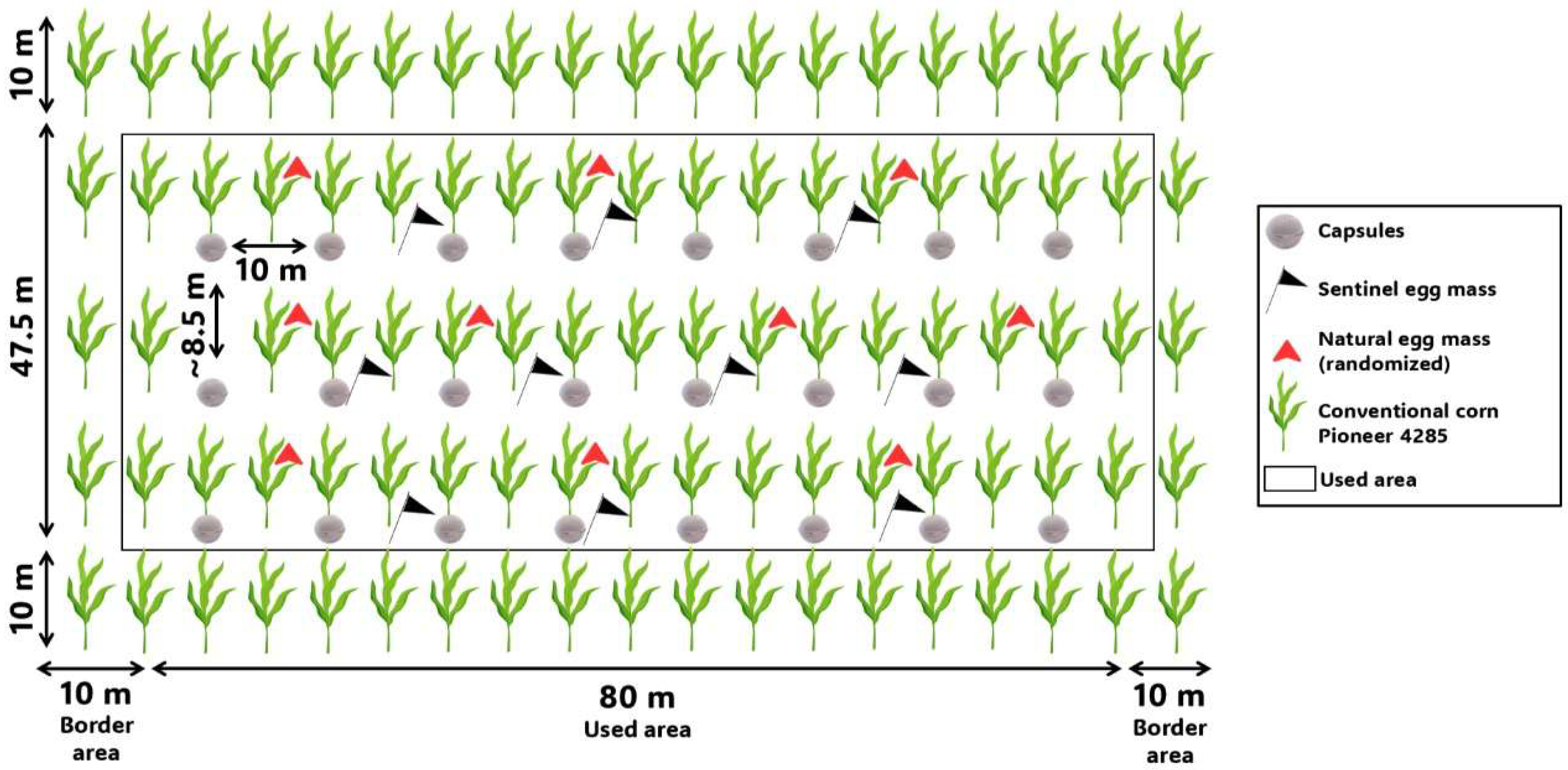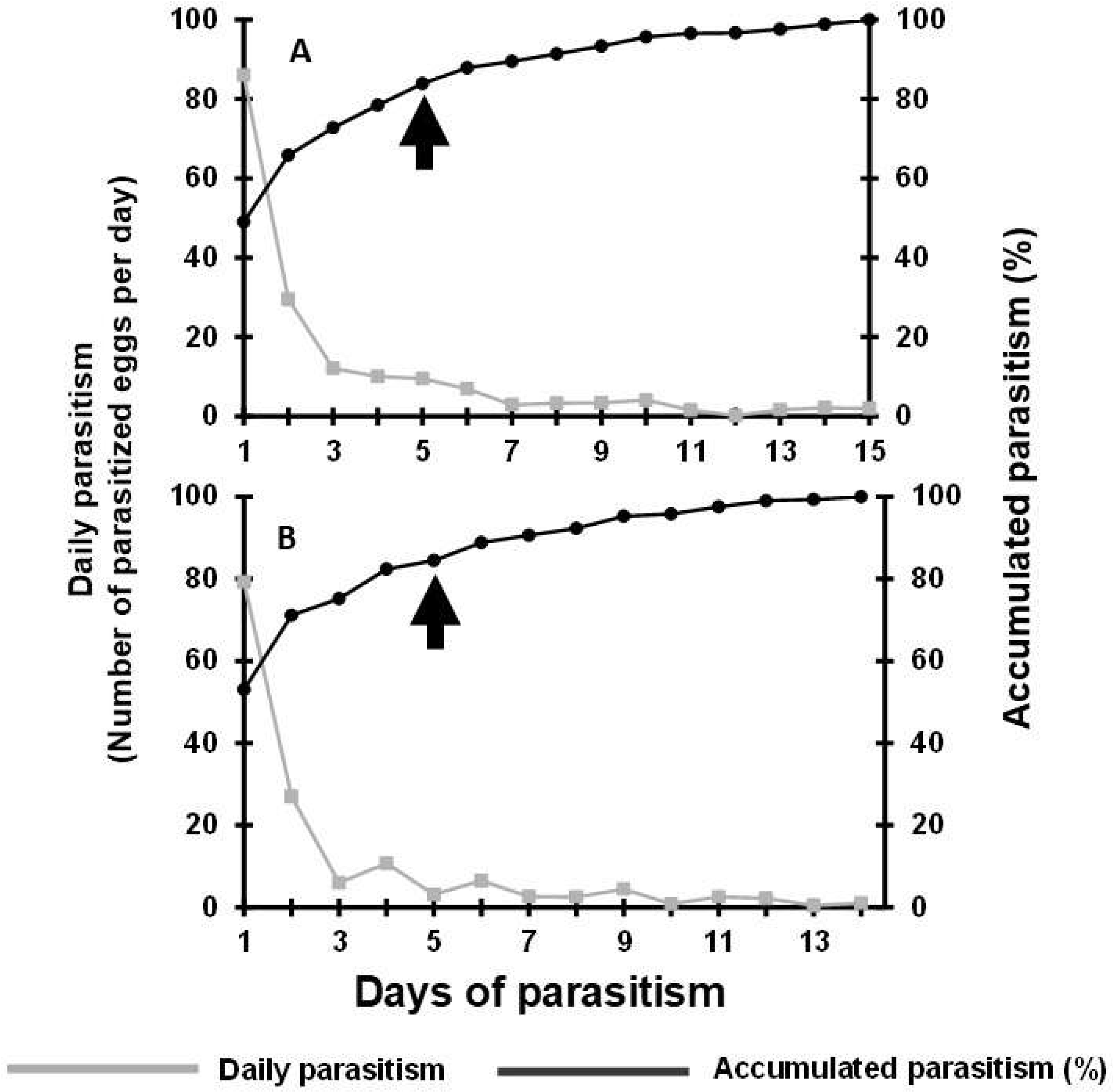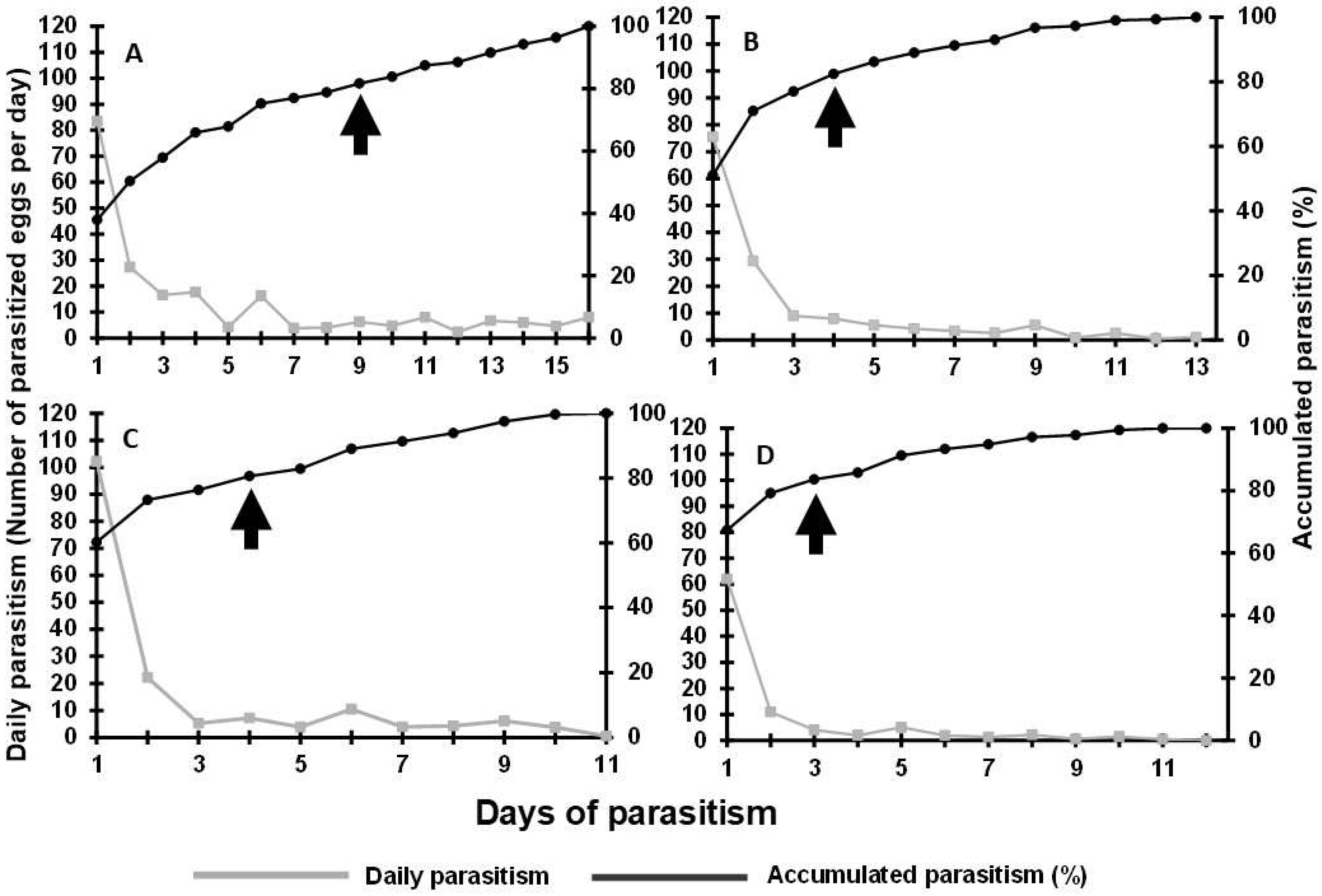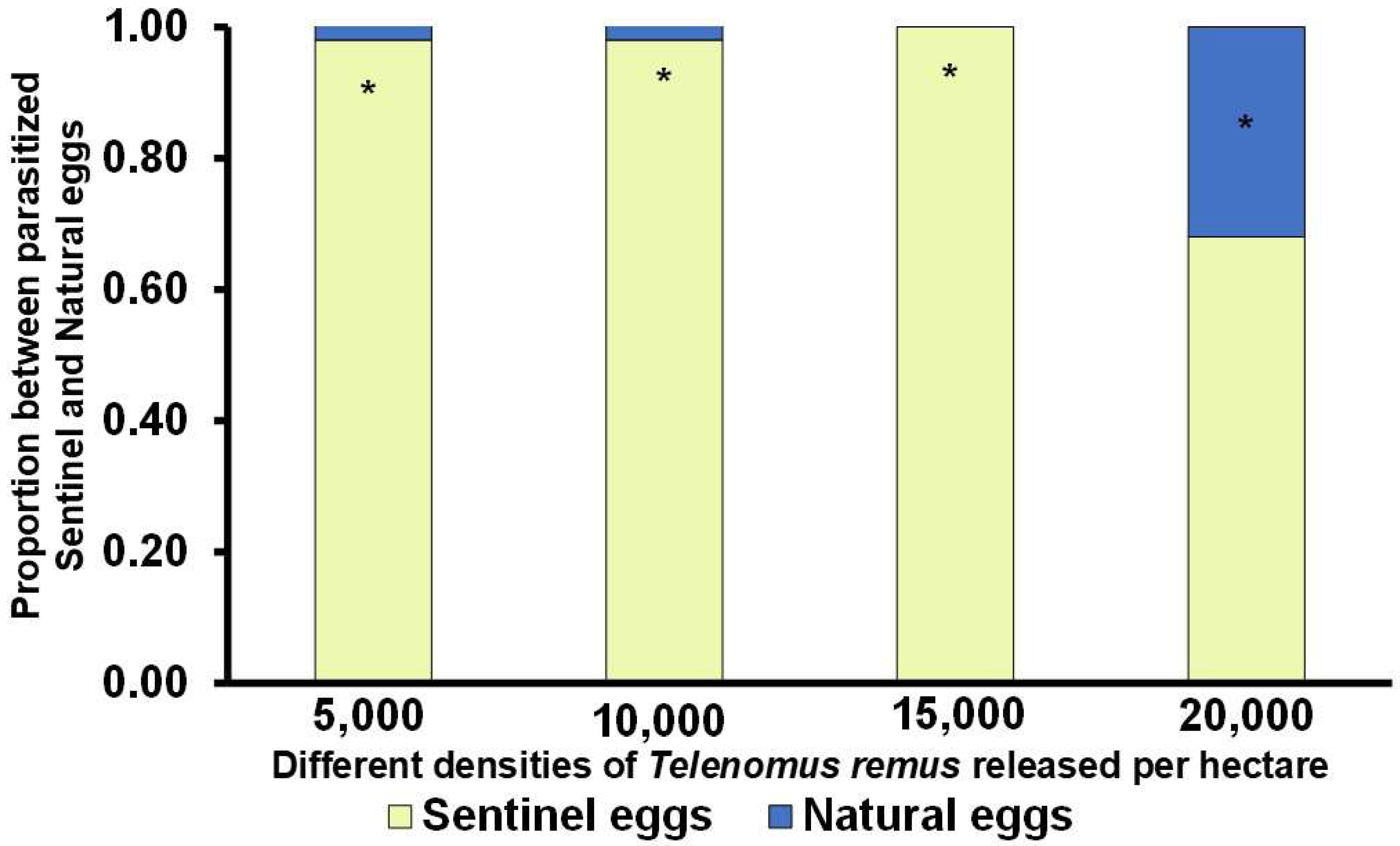Improving Telenomus remus (Hymenoptera: Scelionidae) Adoption: Contribution of Different Egg Parasitoid Densities, Fed Adults, and Their Storage for Successful Biological Control of Spodoptera frugiperda (Lepidoptera: Noctuidae)
Simple Summary
Abstract
1. Introduction
2. Materials and Methods
2.1. Insect Rearing
2.2. Experiment 1: Parasitism Capacity of Telenomus remus Fed on Liquid (Honey-Droplet Diet) vs. Honey-Solid Diet
2.3. Experiment 2: Shelf Life of Telenomus remus Adults Inside Capsules with Honey-Solid Diet
2.4. Experiment 3: Field Performance of Telenomus remus Fed Honey-Solid Under Different Release Densities
2.5. Statistical Analysis
3. Results
3.1. Experiment 1: Parasitism Capacity of Telenomus remus Fed on Liquid (Honey-Droplet Diet) vs. Honey-Solid Diet
3.2. Experiment 2: Shelf Life (Storage Period in Days) of Telenomus remus Adults Inside Capsules with a Honey-Solid Diet
3.3. Experiment 3: Field Performance of Telenomus remus Fed Honey-Solid Under Different Release Densities
4. Discussion
5. Conclusions
Supplementary Materials
Author Contributions
Funding
Data Availability Statement
Acknowledgments
Conflicts of Interest
References
- Kenis, M.; Benelli, G.; Biondi, A.; Calatayud, P.-A.; Day, R.; Desneux, N.; Harrison, R.D.; Kriticos, D.; Rwomushana, I.; van den Berg, J.; et al. Invasiveness, biology, ecology, and management of the fall armyworm, Spodoptera frugiperda. Entomol. Gen. 2022, 43, 187–241. [Google Scholar] [CrossRef]
- Montezano, D.G.; Specht, A.; Sosa-Gómez, D.R.; Roque-Specht, V.F.; Malaquias, J.V.; Paula-Moraes, S.V.; Peterson, J.A.; Hunt, T.E. Biotic potential and reproductive parameters of Spodoptera frugiperda (J.E. Smith, 1797) (Lepidoptera: Noctuidae). J. Agric. Sci. 2019, 11, 240–252. [Google Scholar] [CrossRef]
- Bakrya, M.M.S.; Abdel-Baky, N.F. Impact of the fall armyworm, Spodoptera frugiperda (Lepidoptera: Noctuidae) infestation on maize growth characteristics and yield loss. Braz. J. Biol. 2023, 84, e274602. [Google Scholar] [CrossRef] [PubMed]
- Horikoshi, R.J.; Vertuan, H.; Castro, A.A.; Morrell, K.; Griffith, C.; Evans, A.; Tan, J.; Asiimwe, P.; Anderson, H.; José, M.O.M.A.; et al. A new generation of Bt maize for control of fall armyworm (Spodoptera frugiperda). Pest Manag. Sci. 2021, 77, 3227–3736. [Google Scholar] [CrossRef] [PubMed]
- Yang, F.; Wang, Z.; Kerns, D.L. Resistance of Spodoptera frugiperda to Cry1, Cry2, and Vip3Aa Proteins in Bt Corn and Cotton in the Americas: Implications for the Rest of the World. J. Econ. Entomol. 2022, 115, 1752–1760. [Google Scholar] [CrossRef] [PubMed]
- Ngegba, P.M.; Khalid, M.Z.; Jiang, W.; Zhong, G. An overview of insecticide resistance mechanisms, challenges, and management strategies in Spodoptera frugiperda. Crop Prot. 2025, 197, 107322. [Google Scholar] [CrossRef]
- van den Berg, J.; du Plessis, H. Chemical control and insecticide resistance in Spodoptera frugiperda (Lepidoptera: Noctuidae). J. Econ. Entomol. 2022, 115, 1761–1771. [Google Scholar] [CrossRef]
- Nougadère, A.; Rzpecka, D.; Makowski, D.; Paoli, F.; Turillazzi, F.; Scala, M.; Sánchez, B.; Baldassarre, F.; Tramontini, S.; Vos, S. Spodoptera frugiperda—Pest Report to Support the Ranking of EU Candidate Priority Pests; EFSA Supporting Publication; EFSA European Food Safety Authority: Parma, Italy, 2025; Volume 22, p. EN-9266. [Google Scholar] [CrossRef]
- Ahmad, M.F.; Ahmad, F.A.; Alsayegh, A.A.; Zeyaullah, M.; AlShahrani, A.M.; Muzammil, K.; Saati, A.A.; Wahab, S.; Elbendary, E.Y.; Kambal, N.; et al. Pesticides impacts on human health and the environment with their mechanisms of action and possible countermeasures. Heliyon 2024, 10, e29128. [Google Scholar] [CrossRef]
- Agboyi, L.; Layodé, B.F.R.; Fening, K.O.; Beseh, P.; Attuquaye Clottey, V.; Day, R.; Kenis, M.; Babendreier, D. Assessing the potential of inoculative field releases of Telenomus remus to control Spodoptera frugiperda in Ghana. Insects 2021, 12, 665. [Google Scholar] [CrossRef]
- EPPO. EPPO Global Database: Spodoptera frugiperda Distribution. Available online: https://gd.eppo.int/taxon/LAPHFR/distribution (accessed on 20 June 2025).
- Sagar, G.C.; Aastha, B.; Laxman, K. An introduction of fall armyworm (Spodoptera frugiperda) with management strategies: A review paper. Nipp. J. Environ. Sci. 2020, 1, 1010. [Google Scholar] [CrossRef]
- Togola, A.; Beyene, Y.; Bocco, R.; Tepa-Yotto, G.; Gowda, M.; Too, A.; Boddupalli, P. Fall armyworm (Spodoptera frugiperda) in Africa: Insights into biology, ecology and impact on staple crops, food systems and management approaches. Front. Agron. 2025, 7, 1538198. [Google Scholar] [CrossRef]
- Wyckhuys Kris, A.G. The Wonder and Importance of Biological Control in Farming and Agrifood Systems; IFPRI blog; International Food Policy Research Institute: Washington, DC, USA, 2024; Available online: https://www.ifpri.org/blog/the-wonder-and-importance-of-biological-control-in-farming-and-agrifood-systems/ (accessed on 4 October 2025).
- Bueno, A.F.; Sutil, W.P.; Cingolani, M.F.; Colmenarez, Y.C. Using egg parasitoids to manage caterpillars in soybean and maize: Benefits, challenges, and major recommendations. Insects 2024, 15, 869. [Google Scholar] [CrossRef]
- Ardina, A.; Bakti, D.; Tobing, M.C.L.; Ubaidillah, R.; Darmawan, D. Parasitism capacity of Telenomus sp. (Hymenoptera: Scelionidae) on Spodoptera frugiperda, in refugia system. Int. J. Basic App. Sci. 2024, 12, 183–193. [Google Scholar] [CrossRef]
- Kenis, M.; du Plessis, H.; van den Berg, J.; Ba, M.N.; Goergen, G.; Kwadjo, K.E. Telenomus remus, a candidate parasitoid for the biological control of Spodoptera frugiperda in Africa, is already present on the continent. Insects 2019, 10, 92. [Google Scholar] [CrossRef] [PubMed]
- Colmenarez, Y.C.; Babendreier, D.; Ferrer Wurst, F.R.; Vásquez-Freytez, C.L.; Bueno, A.F. The use of Telenomus remus (Nixon, 1937) (Hymenoptera: Scelionidae) in the management of Spodoptera spp.: Potential, challenges, and main benefits. CABI Agric. Biosci. 2022, 3, 5. [Google Scholar] [CrossRef]
- Li, T.H.; Bueno, A.F.; Desneux, N.; Zhang, L.; Wang, Z.; Dong, H.; Wang, S.; Zang, L.S. Current status of biological control of fall armyworm Spodoptera frugiperda by egg parasitoids. J. Pest Sci. 2023, 96, 1345–1363. [Google Scholar] [CrossRef]
- Gonzalez-Cabrera, J.; García-García, R.E.; Vega-Chavez, J.L.; Contreras-Bermudez, Y.; Mejía-García, N.; Ángeles-Chavez, E.; Sanchez-Gonzalez, J.A. Biological and population parameters of Telenomus remus and Trichogramma atopovirilia as biological control agents for Spodoptera frugiperda. Crop Prot. 2025, 188, 106995. [Google Scholar] [CrossRef]
- Pomari-Fernandes, A.; Bueno, A.F.; De Bortoli, S.A.; Favetti, B.M. Dispersal capacity of the egg parasitoid Telenomus remus Nixon (Hymenoptera: Platygastridae) in maize and soybean crops. Biol. Control 2018, 126, 158–168. [Google Scholar] [CrossRef]
- Pomari, A.F.; Bueno, A.F.; Bueno, R.C.O.F.; Menezes Junior, A.O.; Fonseca, A.C.P.F. Releasing number of Telenomus remus (Nixon) (Hymenoptera: Platygastridae) against Spodoptera frugiperda Smith (Lepidoptera: Noctuidae) in corn, cotton, and soybean. Ciênc. Rural 2013, 43, 377–382. [Google Scholar] [CrossRef]
- Exteckoetter, V.; Oliveira, J.A.C.; Figueiredo, K.G.; Bueno, A.F.; Carvalho, G.A. Side effects of insecticides used in soybean and corn on the egg parasitoid Telenomus remus (Hymenoptera: Scelionidae). Ecotoxicology 2025, 34, 1266–1275. [Google Scholar] [CrossRef] [PubMed]
- Melo, M.C.; Coelho, A., Jr.; Garcia, A.G.; Parra, J.R.P. Mass rearing requirements and ecological zoning of Telenomus remus estimated through life table in different temperatures and relative humidities. Biol. Control 2024, 195, 105546. [Google Scholar] [CrossRef]
- Mubayiwa, M.; Machekano, H.; Mvumi, B.M.; Opio, W.A.; Segaiso, B.; Chidawanyika, F.; Nyamukondiwa, C. Thermal performance drifts between the egg parasitoid Telenomus remus and the fall armyworm may threaten the efficacy of biological control under climate change. Entomol. Exp. Appl. 2025, 173, 338–350. [Google Scholar] [CrossRef]
- Pinto, C.P.G.; Romanello, N. Functional response of Telenomus remus (Hymenoptera: Scelionidae) to different egg densities of Spodoptera frugiperda (Lepidoptera: Noctuidae). Arq. Inst. Biol. 2025, 92, e0082024. [Google Scholar] [CrossRef]
- Sampaio, F.; Marchioro, C.A.; Foerster, L.A. Can Telenomus remus and Trichogramma foersteri be used in combination against the fall armyworm, Spodoptera frugiperda? J. Appl. Entomol. 2024, 148, 651–657. [Google Scholar] [CrossRef]
- Yu, G.; Sheng, L.; Zhang, Z.; Zou, Q.; Lai, X.; Tang, Y.; Li, Y.; Liu, J.; Yan, H.; Xie, X.; et al. Molecular insights into diapause mechanisms in Telenomus remus for Improved biological control. Insects 2025, 16, 393. [Google Scholar] [CrossRef]
- Yaseen, M.; Bennett, F.D.; Barrow, R.M. Introduction of exotic parasites for control of Spodoptera frugiperda in Trinidad, the eastern Caribbean and Latin America. In Urgent Plant Pest and Disease Problems in the Caribbean; Braithwaite, C.W.D., Pollard, G.V., Eds.; Inter-American Institute for Cooperation on Agriculture: Ocho Rios, Jamaica, 1981; pp. 161–171. [Google Scholar]
- Cock, M.J.W. A review of biological control of pests in the Commonwealth Caribbean and Bermuda up to 1982. In Commonwealth Institute of Biological Control Technical Communication; Commonwealth Institute of Biological Control: Farnham Royal, UK, 1985. [Google Scholar]
- Hernández, D.; Ferrer, F.; Linares, B. Introducción de Telenomus remus Nixon (Hym: Scelionidae) para controlar Spodoptera frugiperda (Lep: Noctuidae) en Yaritagua, Venezuela. Agron. Trop. 1989, 39, 199–205. [Google Scholar]
- García-Roa, F.; Mosquera, E.M.T.; Vargas, S.C.A.; Rojas, A.L. Control biológico, microbiológico y físico de Spodoptera frugiperda (Lepidoptera: Noctuidae), plaga del maíz y otros cultivos en Colombia. Rev. Colomb. Entomol. 2002, 28, 53–60. [Google Scholar] [CrossRef]
- Ferrer, W.F. Biological control of agricultural pests in Venezuela: Historical achievements of Servicio Biológico (SERVBIO). Rev. Cienc. Ambient. 2021, 55, 327–344. [Google Scholar] [CrossRef]
- Pinto, A.S.; Parra, J.R.P. Liberação de inimigos naturais. In Controle Biológico no Brasil: Parasitoides e Predadores; Parra, J.R.P., Botelho, P.S.M., Corrêa-Ferreira, B.S., Bento, J.M.S., Eds.; Manole: Barueri, SP, Brazil, 2002; pp. 325–342. [Google Scholar]
- Schwartz, A.; Gerling, D. Adult biology of Telenomus remus [Hymenoptera: Scelionidae] under laboratory conditions. Entomophaga 1974, 19, 483–492. [Google Scholar] [CrossRef]
- Denis, D.; Pierre, J.S.; van Baaren, J.; van Alphen, J.J. How temperature and habitat quality affect parasitoid lifetime reproductive success—A simulation study. Ecol. Model. 2011, 222, 1604–1613. [Google Scholar] [CrossRef]
- Romo, C.M.; Tylianakis, J.M. Elevated temperature and drought interact to reduce parasitoid effectiveness in suppressing hosts. PLoS ONE 2013, 8, e58136. [Google Scholar] [CrossRef]
- Sampaio, F.; Marchioro, C.A.; Foerster, L.A. Modeling parasitoid development: Climate change impacts on Telenomus remus (Nixon) and Trichogramma foersteri (Takahashi) in southern Brazil. Pest Manag. Sci. 2025, 81, 5335–5349. [Google Scholar] [CrossRef] [PubMed]
- Grande, M.L.M.; Queiroz, A.P.; Gonçalves, J.; Hayashida, R.; Ventura, M.U.; Bueno, A.F. Impact of environmental variables on parasitism and emergence of Trichogramma pretiosum, Telenomus remus and Telenomus podisi. Neotrop. Entomol. 2021, 50, 605–614. [Google Scholar] [CrossRef] [PubMed]
- Parra, J.R.P. Biological control in Brazil: An overview. Sci. Agric. 2014, 71, 345–355. [Google Scholar] [CrossRef]
- Gomes Garcia, A.; Wajnberg, E.; Parra, J.R.P. Optimizing the releasing strategy used for the biological control of the sugarcane borer Diatraea saccharalis by Trichogramma galloi with computer modeling and simulation. Sci. Rep. 2024, 14, 9535. [Google Scholar] [CrossRef]
- Linares, B. Farm family rearing of egg parasites in Venezuela. Biocontrol News Inf. 1998, 19, 76N. [Google Scholar]
- Cave, R.D.; Acosta, N.M. Telenomus remus Nixon: Un parasitoide en el control biológico del gusano cogollero, Spodoptera frugiperda (Smith). Ceiba 1999, 40, 215–227. [Google Scholar]
- Ferrer, F. Biological of agricultural insect pest in Venezuela; advances, achievements, and future perspectives. Biocontrol News Inf. 2001, 22, 67–74. [Google Scholar]
- Figueiredo, M.L.C.; Lucia, T.M.C.D.; Cruz, I. Effect of Telenomus remus Nixon (Hymenoptera: Scelionidae) density on control of Spodoptera frugiperda (Smith) (Lepidoptera: Noctuidae) egg masses upon release in a maize field. Rev. Bras. Milho Sorgo 2002, 1, 12–19. [Google Scholar] [CrossRef]
- Cruz, I. Controle biológico de pragas na cultura de milho para a produção de conservas (minimilho) por meio de parasitoides e predadores. In Circular Técnica; Embrapa Milho e Sorgo: Sete Lagoas, Brazil, 2007; Volume 91, p. 16. [Google Scholar]
- Varella, A.C.; Menezes-Netto, A.C.; Alonso, J.D.S.; Caixeta, D.F.; Peterson, R.K.D.; Fernandes, O.A. Mortality dynamics of Spodoptera frugiperda (Lepidoptera: Noctuidae) immatures in maize. PLoS ONE 2015, 10, e0130437. [Google Scholar] [CrossRef]
- Ivan, I.A.F.; Silva, K.R.; Loboschi, D.L.; Araujo-Junior, L.P.; Sanots, A.J.P.S.; Pinto, A.S. Número de liberações de Telenomus remus no controle de ovos de Spodoptera frugiperda em milho de segunda safra. In Proceedings of the XXXI Congresso Nacional de Milho e Sorgo, Bento Gonçalves, Brazil, 25 September 2016; pp. 289–293. [Google Scholar]
- Rezende, S.K.; Loboschi, D.L.; Alexandre, N.O.; Carneiro, R.P.; Arroyo, B.M.; Pinto, A.S. Quantidade liberada de Telenomus remus no controle de ovos de Spodoptera frugiperda em milho de segunda safra. In Proceedings of the XXXI Congresso Nacional de Milho e Sorgo, Bento Gonçalves, Brazil, 25 September 2016; pp. 308–313. Available online: http://www.abms.org.br/cnms2016_trabalhos/docs/1145.pdf (accessed on 4 October 2025).
- Salazar-Mendoza, P.; Rodriguez-Saona, C.; Fernandes, O.A. Release density, dispersal capacity, and optimal rearing conditions for Telenomus remus, an egg parasitoid of Spodoptera frugiperda, in maize. Biocontrol Sci. Technol. 2020, 3, 1040–1059. [Google Scholar] [CrossRef]
- Collier, T.; van Steenwyk, R. A critical evaluation of augmentative biological control. Biol. Control 2004, 31, 245–256. [Google Scholar] [CrossRef]
- Crowder, D.W. Impact of release rates on the effectiveness of augmentative biological control agents. J. Insect Sci. 2007, 7, 15. [Google Scholar] [CrossRef] [PubMed]
- Heimpel, G.E.; Abram, P.K.; Causton, C.E.; Celis, S.L.; Coll, M.; Hardy, I.C.W.; Mangel, M.; Mills, N.J.; Segoli, M. A benefit–risk analysis for biological control introductions based on the protection of native biodiversity. Ecol. Appl. 2024, 34, e3012. [Google Scholar] [CrossRef] [PubMed]
- Roswadoski, L.; Sutil, W.P.; Carneiro, G.S.; Maciel, R.M.A.; Coelho Jr, A.; Bueno, A.F. Release strategy and egg parasitism of Telenomus podisi adults fed with different diets. Biol. Control 2024, 198, 105626. [Google Scholar] [CrossRef]
- Sosa-Gómez, D.R.; Corrêa-Ferreira, B.S.; Hoffmann-Campo, C.B.; Corso, I.C.; Oliveira, L.J.; Moscardi, F.; Panizzi, A.R.; Bueno, A.F.; Hirose, E.; Roggia, S. Manual de Identificação de Insetos e Outros Invertebrados da Cultura da Soja; Embrapa Soja: Londrina, Brazil, 2014. [Google Scholar]
- Greene, G.L.; Leppla, N.C.; Dickerson, W.A. Velvet bean caterpillar: A rearing procedure and artificial medium. J. Econ. Entomol. 1976, 69, 488–497. [Google Scholar] [CrossRef]
- Butt, B.A. Sex Determination of Lepidopterous Pupae; USDA: Washington, DC, USA, 1962; pp. 33–75.
- Brooks, M.E.; Kristensen, K.; van Benthem, K.J.; Magnusson, A.; Berg, C.W.; Nielsen, A.; Skaug, H.J.; Mächler, M.; Bolker, B.M. glmmTMB balances speed and flexibility among packages for zero-inflated generalized linear mixed modeling. R J. 2017, 9, 378–400. [Google Scholar] [CrossRef]
- Lenth, R. Emmeans: Estimated Marginal Means, Aka Least-Squares Means; R Package Version 1.8.6, 2023. Available online: https://CRAN.R-project.org/package=emmeans (accessed on 31 July 2025).
- R Core Team. R: A Language and Environment for Statistical Computing; R Foundation for Statistical Computing: Vienna, Austria, 2023; Available online: https://www.R-project.org/ (accessed on 31 July 2025).
- Bueno, A.F.; Braz, É.C.; Favetti, B.M.; de Barros França-Neto, J.; Silva, G.V. Release of the egg parasitoid Telenomus podisi to manage the Neotropical Brown Stink Bug, Euschistus heros, in soybean production. Crop Prot. 2020, 137, 105310. [Google Scholar] [CrossRef]
- Braz, É.C.; Bueno, A.F.; Colombo, F.C.; Queiroz, A.P. Temperature impact on Telenomus podisi emergence in field releases of unprotected and encapsulated parasitoid pupae. Neotrop. Entomol. 2021, 50, 462–469. [Google Scholar] [CrossRef]
- Bueno, A.F.; Sutil, W.P.; Maciel, R.M.A.; Roswadoski, L.; Colmenarez, Y.C.; Colombo, F.C. Challenges and opportunities of using egg parasitoids in augmentative biological control of FAW in Brazil. Biol. Control 2023, 186, 105344. [Google Scholar] [CrossRef]
- Shen, Z.; Liu, L.H.; Zang, L.S.; Tie-Jun Deng, T.-J.; Luo, Z.-B.; Gao, J.-Y.; Tang, L.-D. Evaluation of Telenomus remus (Hymenoptera: Platygastridae) as a biocontrol agent of Spodoptera litura (Lepidoptera: Noctuidae) based on two-sex life table and functional response analyses. CABI Agric. Biosci. 2023, 4, 48. [Google Scholar] [CrossRef]
- Cave, R.D. Biology, ecology and use in pest management of Telenomus remus. Biocontrol News Inf. 2000, 21, 21–26. [Google Scholar]
- Lewis, W.; Stapel, J.O.; Cortesero, A.M.; Takasu, K. Understanding how parasitoids balance food and host needs: Importance to biological control. Biol. Control 1998, 11, 175–183. [Google Scholar] [CrossRef]
- Farahani, H.K.; Moghadassi, Y.; Pierre, J.-S.; Kraus, S.; Lihoreau, M. Poor adult nutrition impairs learning and memory in a parasitoid wasp. Sci. Rep. 2021, 11, 16220. [Google Scholar] [CrossRef] [PubMed]
- Kishinevsky, M.; Keasar, T.; Sivinski, J.; Segoli, M. Sugar feeding increases the lifespan and parasitism rates of a parasitoid wasp under field conditions. Ecol. Entomol. 2018, 43, 621–628. [Google Scholar] [CrossRef]
- Straser, R.K.; Wilson, H. Food deprivation alters reproductive performance of biocontrol agent Hadronotus pennsylvanicus. Sci. Rep. 2022, 12, 11322. [Google Scholar] [CrossRef]
- Montecelli, L.S.; Tena, A.; Idier, M.; Amiens-Desneux, E.; Desneux, N. Quality of aphid honeydew for a parasitoid varies as a function of both aphid species and host plant. Biol. Control 2020, 140, 104099. [Google Scholar] [CrossRef]
- Tuncbilek, A.S.; Bilbil, H.; Bakir, S.; Silici, S. The performance of Trichogramma (Hymenoptera: Trichogrammatidae) parasitoids feeding on honey sources. Tarım Bilimleri Derg. 2021, 27, 400–406. [Google Scholar] [CrossRef]
- Bueno, R.C.O.F.; Carneiro, T.R.; Bueno, A.F.; Pratissoli, D.; Fernandes, O.A.; Vieira, S.S. Parasitism capacity of Telenomus remus Nixon (Hymenoptera: Scelionidae) on Spodoptera frugiperda (Smith) (Lepidoptera: Noctuidae) eggs. Braz. Arch. Biol. Technol. 2010, 53, 1339. [Google Scholar] [CrossRef]
- (MAPA) Ministério da Agricultura e Pecuária. Portaria MAPA/SDA N° 1127 DE 11/06/2024, Published in the DOU on 24 June 2024. Available online: https://www.gov.br/agricultura/pt-br/assuntos/insumos-agropecuarios/insumos-agricolas/agrotoxicos/produtos-fitossanitarios/copy_of_2024253059e60PORTARIASDA_MAPAN1.127DE11DEJUNHODE20241.pdf (accessed on 4 October 2025). (In Portuguese)
- Vieira, N.F.; Pomari-Fernandes, A.; Lemes, A.A.F.; Vacari, A.M.; De Bortoli, S.A.; Bueno, A.F. Cost of production of Telenomus remus (Hymenoptera: Platygastridae) grown in natural and alternative hosts. J. Econ. Entomol. 2017, 110, 2724–2726. [Google Scholar] [CrossRef]
- Axmatovich, J.R. In vitro rearing of parasitoids (Hymenoptera: Trichogrammatidae and Braconidae). Tex. J. Agric. Biol. Sci. 2022, 4, 33–37. [Google Scholar]
- Hurali, S.; Narwade, D.K.; Guntupalli, S.; Sarangi, S.; Babu, S.B.; Pandey, A.; Thodusu, M.; Patel, R. Innovations in artificial rearing and mass production of beneficial insects for biocontrol: A review. Uttar Pradesh J. Zool. 2025, 46, 110–125. [Google Scholar] [CrossRef]
- Volp, T.M.; Zalucki, M.P.; Furlong, M.J. What defines a host? Oviposition behavior and larval performance of Spodoptera frugiperda (Lepidoptera: Noctuidae) on five putative host plants. J. Econ. Entomol. 2022, 115, 1744–1751. [Google Scholar] [CrossRef]
- Queiroz, A.P.D.; Favetti, B.M.; Luski, P.G.G.; Gonçalves, J.; Neves, P.M.O.J.; Bueno, A.D.F. Telenomus remus (Hymenoptera: Platygastridae) parasitism on Spodoptera frugiperda (Lepidoptera: Noctuidae) eggs: Different parasitoid and host egg ages. Semin. Ciências Agrárias 2019, 40, 2933–2946. [Google Scholar] [CrossRef]
- Queiroz, A.P.D.; Bueno, A.D.F.; Pomari-Fernandes, A.; Bortolotto, O.C.; Mikami, A.Y.; Olive, L. Influence of host preference, mating, and release density on the parasitism of Telenomus remus (Nixon) (Hymenoptera, Platygastridae). Rev. Bras. Entomol. 2017, 61, 86–90. [Google Scholar] [CrossRef]





| Diet | Lifetime Number of Parasitized Eggs/Female 1 | Emergence (%) 2 | Progeny Sex Ratio 2 | Parental Longevity of Adult Females (Days) 3 |
|---|---|---|---|---|
| 100% honey in tiny droplets (honey-droplet diet) | 165.4 ± 5.88 a | 77.7 ± 1.84 a | 0.69 ± 0.04 a | 10.4 ± 0.71 a |
| 100% honey in macerated cotton strings (honey-solid diet) | 143.4 ± 4.57 b | 73.7 ± 1.01 b | 0.70 ± 0.02 a | 10.1 ± 0.40 a |
| Days of storage After Parasitoid Emergence | Lifetime Number of Parasitized Eggs/Female 1 | Emergence (%) 2 | Progeny Sex Ratio 2 | Parental Longevity of Adult Females (Days) 3 |
|---|---|---|---|---|
| 2 | 193.4 ± 8.82 a | 79.9 ± 1.78 a | 0.74 ± 0.02 a | 11.5 ± 0.63 a |
| 4 | 143.6 ± 4.35 b | 74.4 ± 1.75 b | 0.80 ± 0.01 a | 10.0 ± 0.35 a |
| 6 | 150.4 ± 14.79 b | 76.5 ± 1.79 b | 0.56 ± 0.04 b | 7.4 ± 0.69 b |
| 8 | 86.6 ± 5.63 c | 80.5 ± 1.88 a | 0.71 ± 0.08 a | 7.1 ± 0.54 b |
| Days After Parasitoid Emergence | Emergence (%) of Adults from Pupae Inside Capsules | Dead Adults (%) Trapped Inside Capsules |
|---|---|---|
| 2 | 69.8 ± 2.76 a | 2.1 ± 0.61 a |
| 4 | 74.6 ± 2.56 a | 5.2 ± 0.50 b |
| 6 | 73.3 ± 3.58 a | 5.9 ± 1.03 b |
| 8 | 75.0 ± 0.97 a | 5.5 ± 0.80 b |
Disclaimer/Publisher’s Note: The statements, opinions and data contained in all publications are solely those of the individual author(s) and contributor(s) and not of MDPI and/or the editor(s). MDPI and/or the editor(s) disclaim responsibility for any injury to people or property resulting from any ideas, methods, instructions or products referred to in the content. |
© 2025 by the authors. Licensee MDPI, Basel, Switzerland. This article is an open access article distributed under the terms and conditions of the Creative Commons Attribution (CC BY) license (https://creativecommons.org/licenses/by/4.0/).
Share and Cite
Sutil, W.P.; de F. Bueno, A.; Roswadoski, L.; Iasczczaki, R.S.; Carneiro, G.S.; Colmenarez, Y.C. Improving Telenomus remus (Hymenoptera: Scelionidae) Adoption: Contribution of Different Egg Parasitoid Densities, Fed Adults, and Their Storage for Successful Biological Control of Spodoptera frugiperda (Lepidoptera: Noctuidae). Insects 2025, 16, 1032. https://doi.org/10.3390/insects16101032
Sutil WP, de F. Bueno A, Roswadoski L, Iasczczaki RS, Carneiro GS, Colmenarez YC. Improving Telenomus remus (Hymenoptera: Scelionidae) Adoption: Contribution of Different Egg Parasitoid Densities, Fed Adults, and Their Storage for Successful Biological Control of Spodoptera frugiperda (Lepidoptera: Noctuidae). Insects. 2025; 16(10):1032. https://doi.org/10.3390/insects16101032
Chicago/Turabian StyleSutil, Weidson P., Adeney de F. Bueno, Leonardo Roswadoski, Rafael S. Iasczczaki, Gabriel S. Carneiro, and Yelitza C. Colmenarez. 2025. "Improving Telenomus remus (Hymenoptera: Scelionidae) Adoption: Contribution of Different Egg Parasitoid Densities, Fed Adults, and Their Storage for Successful Biological Control of Spodoptera frugiperda (Lepidoptera: Noctuidae)" Insects 16, no. 10: 1032. https://doi.org/10.3390/insects16101032
APA StyleSutil, W. P., de F. Bueno, A., Roswadoski, L., Iasczczaki, R. S., Carneiro, G. S., & Colmenarez, Y. C. (2025). Improving Telenomus remus (Hymenoptera: Scelionidae) Adoption: Contribution of Different Egg Parasitoid Densities, Fed Adults, and Their Storage for Successful Biological Control of Spodoptera frugiperda (Lepidoptera: Noctuidae). Insects, 16(10), 1032. https://doi.org/10.3390/insects16101032







